Bodnant Garden - A Rippin Yarn!
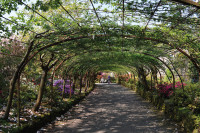
I felt like I had won the weather lottery as I drove past what seemed like hundreds of cars parked outside Bodnant Garden. It was a gloriously sunny day, sandwiched between the other wetter and colder days that week, and how great it was to be able to conduct an interview outside in the warmth.
Now, I have read about Bodnant and the admiration it receives from National Trust members and horticultural enthusiasts, but I wasn't prepared to actually have my breath taken away by the sheer variety and splendour of the different areas that make up the garden. I have since recommended it to anyone who will listen.
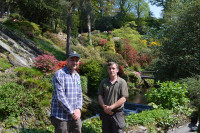
From there, he became Head Gardener at the historic Heale House near Salisbury. "I was there for five years. It's a traditional, archetypal English country garden, so a bit of everything." He then went to Hidcote Manor in Gloucestershire as the Deputy Head Gardener, looking after the Red Borders and the Old Garden. "There was quite a big team to sort out, which was great," John tells me.
"Then I became Head Gardener at Castle Drogo on the edge of Dartmoor, which was a challenge! It was an opportunity to try and revive a garden which no one seemed to really rate but had huge potential. It was an Edward Lutyens design to a fantastic layout but, in recent history, didn't really have the resources put into it. So it was great to be able to get it from a garden that wasn't appreciated to one that was visited and held in more esteem in the gardening world."
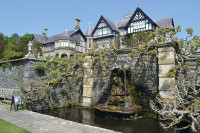
We met up with Mark Morris, who has been gardening at Bodnant for thirty-one years and is a fount of knowledge. "I left school and did the YTS course in horticulture in UCNW in Bangor and struggled, at the time, for work. I worked a short while at a golf course and then I got a fortuitous phone call from one of my old teachers about a job at Bodnant. Through them putting effort in on my part as well, I ended up here and that's it, I've not escaped! I started in 1985, going through City & Guilds 1 and 2, and then young apprentice training on site."
John tells me that he's worked with many gardeners, but that there aren't many as highly skilled and knowledgeable as Mark, "He's quite scary to work with because he expects incredibly high standards. He's brilliant with the students; he enjoys passing on all his knowledge to the next generation."
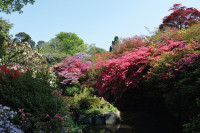
Next year, students from the Historic and Botanic Garden Training programme, a joint venture between the National Trust, English Heritage and the Heritage Lottery Fund, will be working on the garden. "That's been going for ten years with a high success rate. We've got a really good student for next year who we interviewed just last week. There's sixteen National Trust trainees this year on that scheme and there's about twenty-five or so all together."
Bodnant has always had students. "It's really important because there are a lot of skills that are required in this garden that they won't learn anywhere else. Like the waterfall effect of the roses being trained over the tops of the balustrades, the way they tie in the roses on the pergolas and the attention to detail. If we don't train people up, there won't be those skills for the future."
The volunteers at the garden are also an important addition to the team. "They work in teams and with a supervisor. Even the simple things we take for granted, like identifying what is a weed, or not, is a useful skill our volunteers learn," Mark tells me. John says that the volunteers remain loyal. "They get physical exercise, social interaction, a lot of pleasure and a sense of achievement and pride out of it as well."
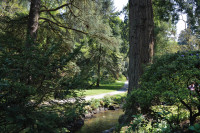
Furnace wood and Furnace meadow will be the next area to open up next spring, which make up about twenty acres. Last year, the team opened another twelve acres of water garden at the far end. The year before that was the Yew Dell, which is about another six acres, and the Old Park the year before that, which is a big meadow at the top of the garden.
"They are all areas that have only had low level maintenance, so we are just taking them up to the higher levels of maintenance," Mark says.
"It's a bit of a revival, and we are hoping we get the visitors that will then mean we can keep more gardeners on to maintain them to a good standard," John tells me. "So far, it's working. We had over 230,000 visitors last year, which smashed all previous records. We've had a relatively cold spring, but hopefully, with a few days like this, our visitor numbers we will soon catch up."
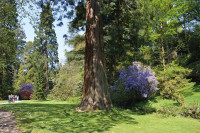
I suggest that it must be more difficult to get the work done now, what with a visitor presence all year round? "The way we worked, you could block paths off, but now we have to think about access and things like that. You have to come up with alternative routes for wheelchair access. It's just a different way of thinking about it; you just change how you work," Mark says.
John prefers it. "I've been in gardens before where you had to put a massive amount of effort in so that it looked pristine when the garden reopened in spring. Whereas now, you never have that because it hopefully always looks good. On the other hand, it was nice when visitors weren't there so we could leave tarps down."
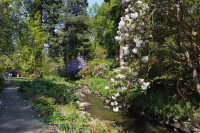
The bad weather at the end of last year brought problems with which many people will be familiar, with heavy flooding on Boxing Day washing away a lot of the new part of the garden. Paths disappeared completely and old drainage pipes were exposed. "We phoned around and pretty much the whole team turned out on New Year's Eve, plus a lot of volunteers and our regional director and property manager. We had a massive clear up day in the pouring rain."
"The visual impact of the floods was devastating. We found many of our newly planted trees, with their roots exposed and labels on, caught in low branches downriver, as well as huge quantities of silt and debris - and even a pair of underpants that gave us something to laugh about rather than cry!"
It wasn't all fun and games though, despite John's light-hearted tone. "It set us back about a month. After Christmas is a critical time to get all the mulch on and make sure everything is pruned and tidy and ready to go. The flooding was quite a spanner in the works."
The area around Bodnant gets about forty-eight inches of rain a year, Mark says, but they are certainly not the rainiest site. "We get localised weather here. We get the rain shadow effect from the mountains. We are fortunate because we don't have the hard winters - a minus 3 to minus 5OC for a couple of days is probably the worst it gets."
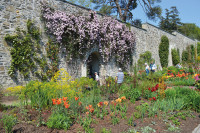
The attention to detail in the garden is obvious, and it is clear that high standards are maintained. "If you want the diversity and the full range of plants that this garden is well known for, then higher maintenance is the order of the day, and you get more visitors and it's more rewarding for us as well," John says.
In between the major projects, the team are upgrading certain areas that need revamping every so often. "The Yucca garden will have a complete overhaul in a year or so and all the terraces also. My predecessor started introducing a lot more herbaceous plants into the garden, but the trouble with herbaceous is every four or five years you then need to revamp them." The herbaceous border on the Canal Terrace had become particularly tired when it came out to make space for the wildflowers this year. "That was originally done in 1994, so it had been in the best part of twenty years, and it showed. Instead of things being at 6ft, they were down at 3ft," Mark tells me.
This does give them the option of changing design however, which is something that John is very keen on: "One of the great things about Bodnant is that it's not stuck in a time warp as some historic gardens are. So there's something about this garden that's always at the cutting edge of design. It gives us the opportunity to do new things. We're going to the Chelsea Flower Show in a couple of weeks to get some ideas and come back with a few ideas that are and going to wow everybody."
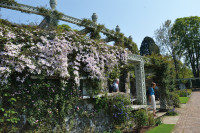
With these projects, there are all sorts of hoops to jump through. The team have their own garden consultants, as well as the donor family for the garden, who have a big say in Bodnant, which John says helps to keep the garden special and unique. "Michael McLaren is the Garden Director, so he has quite a say in keeping the spirit of the place alive and making sure we are keeping things on the right track. Also, we've started to involve the public a bit more. We had a public vote on what mix we should use for the annual meadow, which came out as a classic mix. It's quite nice to get people engaged."
John tells me that, in the last few years, there has been a huge increase in the species brought in. Whilst this could run the risk of potential problems with regards to diseases and pests, the team have an extensive quarantine system in place, with at least a six week period before anything goes into the garden. "We have, in the past, had an issue with phytophthora, or sudden oak death, which affected what we could take in and out of the site. We are clear of that now, thankfully." To prevent another outbreak of phytophthora in the rhododendrons, the team now prune them by thinning out the canopy to create more airflow.
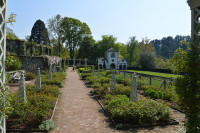
"We're using just a straight nitrogen fertiliser now, just to get everything going a bit. Spraying the roses is kept to the bare minimum that we can get away with. If we do see something, if it can be left, it will be left, just to keep the chemical usage as low as we can."
Organic methods of control are also used, with a lot of mulch put on the garden. "Quite often, we buy it in because we can't generate the quantities that we would like on site. We use pine bark, which we get delivered by the articulated lorry load. It works well because it not only reduces the weeds but also supplies the plants with nutrients: and it's a good control for blackspot and things like as it tends to bury any fungal spores."
"I know the glyphosate decision is coming up, so we're keeping an eye on that. At the moment, we use RoundUp ProVantage to reduce the amount we are putting on. We also go out with a flame weeder, so if there are annuals in the beds we can burn them off with propane guns. It's saving time on hoeing and on chemicals," Mark explains. "Things like the brick path would be the no mix system. That involves staying late because we can't put it down with visitors. It's an after work thing and then roping off and making sure it's all dry. Otherwise, we end up with footprints across the lawn."

When creating new paths, a root protection mesh is used to reduce the amount of compaction on the tree roots close to the surface. "We've got quite a collection of champion trees here," John tells me proudly. "Around twenty or so, which are the tallest of their kind in the UK. We've lost one or two in the high winds recently, so we are quite careful how we manage the rootzones. For example, we had a big oak tree that we had concerns about, with a lot of compaction around the rootzone, so we've now made an exclusion area and put mulch down. The ground was broken up with an airspade to take the compaction out and composted bark put over the top. Then we put spring/summer early bulbs in rather than it being a mass of composted bark."
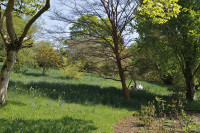
We've put up loads of nest boxes in association with local bird watching groups which have already attracted pied flycatchers. We've also put bird feeders around the garden and the bird life has really increased," John says,
"We are keen to monitor the water quality and trying to improve that where we can too. We have otters in the rivers and the lakes and we would perhaps look at putting a fish pass in at some point because we've got quite a big waterfall and that stops the salmon."
Walking around the various parts of the garden, I was running out of adjectives to express my awe, and was thoroughly aware that I had used my annual allowance for the words "lovely" and "wow". John thinks it's fantastic that the garden has had five generations building on it, as opposed to one generation destroying the work of the previous one. "That's why there's such diversity and maturity, and that's quite rare. That's part of the key to why this place is so great, I think."

"I wake up in the morning wanting to go to work rather than dreading it. I get paid to do something that I want to do," Mark says. "It's the sort of place you could spend your whole life, happily," John finishes. Looking out over the terrace at the start of the Snowdonia range, I would be inclined to agree.
Turfcare at Bodnant
This spring, because of the ground conditions, we've had a verti-drain in to try and get rid of some of the water that's in the ground. We also wanted to get some air in to alleviate compaction, so we tried the Air2G2. These are operations we would not usually do at this time of year because of the amount of visitors that we have, so we try not to do too much on the lawns. This year has been an exception though.
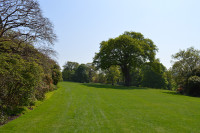
We alternate aeration with verticutting. I recently verticut the croquet terrace with the help of one of the lads who is interested in that procedure. It's a mentoring scheme, so anyone that wants to can learn about turf maintenance as well.
I often end up recommending different bits of kit to visitors who ask about the best way of looking after their lawns. I'm always happy to talk to visitors about our methods and techniques.
From the second week in June onwards is usually our quieter time. Everything is drying out and we are on top of the weeds, so it gives us the opportunity to tackle other jobs that might need doing in the summer; ones that we might not normally get a chance to do.
Then it's just moving on with the mowing. We use Allett cylinder mowers. We'll scarify the lawns through September and October and, once growth has slowed down, we put an autumn and winter fertiliser on the turf. Then it's leaf raking right up until Christmas.
The Year at Bodnant
After Christmas: As soon as we get back after Christmas, we've only got so many weeks before the 'show' starts and the visitors start pouring in. It's a really critical time to make sure that everything is mulched and everything is pruned. We will use the cherry picker to tie in and prune all the wall trained plants, of which we have a vast amount. Then its general maintenance, tidying and making sure everything is looking as good as it can for when the visitors start arriving in greater numbers.
We have two arborists on site and they will be flat out doing as much tree work as possible to ensure that they're safe. They will also prune before the bird nesting season starts. There's also a lot of project work in the winter. With the new areas being opened, that's the time a lot of heavy contractor work will be going on as well.
January: Pretty much the whole month of January is spent tying the Laburnum Arch in and pruning it.
Easter: Before you know it, it's Easter, and that is when the garden has to look immaculate. It's a rush, from the daffodils to the tulips and the magnolias, and then we are at that point when the garden is looking fantastic with all the rhododendrons in bloom as well. Then it's all about general maintenance - mowing and weeding. We do quite a lot of turf maintenance in the spring.

Then another three weeks, after the Laburnum Arch has flowered in July, cutting off the dead heads so all the vigour goes into new growth, and ensuring there aren't any poisonous seeds lying around anywhere.
"Friday Tidy" on a weekly basis to ensure that the garden is looking as good as it can for the weekend.
Autumn: Leaf collecting and putting the garden to bed, cutting all the herbaceous stuff back. This is the time when we are doing a lot of alterations to borders. August, September, October, moving things around in the borders, lifting and splitting herbaceous plants to improve the artistic effect of the borders, which I always enjoy. Then planting as well, tree planting, planting bulbs by the thousand (30,000 extra snowdrops last year alone)!
That's a newish introduction, the amount of bulbs, which provides the under canopy. There's all sorts of things that have come in in the last few years. It may only be a small area, but it picks that area up no end by having that extra layer.
Winter: Then we start the project work again because we've got a big schedule to get through to improve the whole garden and open it up.
There's never a dull moment really. We never get to the point where we can sit down and say "well, that's done".
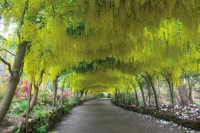
The Laburnum Arch is 145 years old and is regarded as one of the horticultural wonders of the world. 50,000 visitors flock to see it in the month that it is flowering.
It's our most famous feature. The funny thing is that high Victorian features aren't generally in fashion. I like the fact that something high Victorian is our biggest draw.
It does take a huge amount of maintenance and there's renewal plantings as well. Most of it has been renewed; there are very few originals. It requires unique techniques. It's very highly skilled and the craftsmanship is fantastic. Every single knot is tied in the same way. The students will spend some time there going through the principles.
The 'Laburnum Archers' are a whole new type of volunteer that we've introduced this year for the arch. We've had a really big take up, and a whole age range, from fourteen to ninety, including some with disabilities. It helps us out because that is our crazy time of year. It's all hands on deck.
